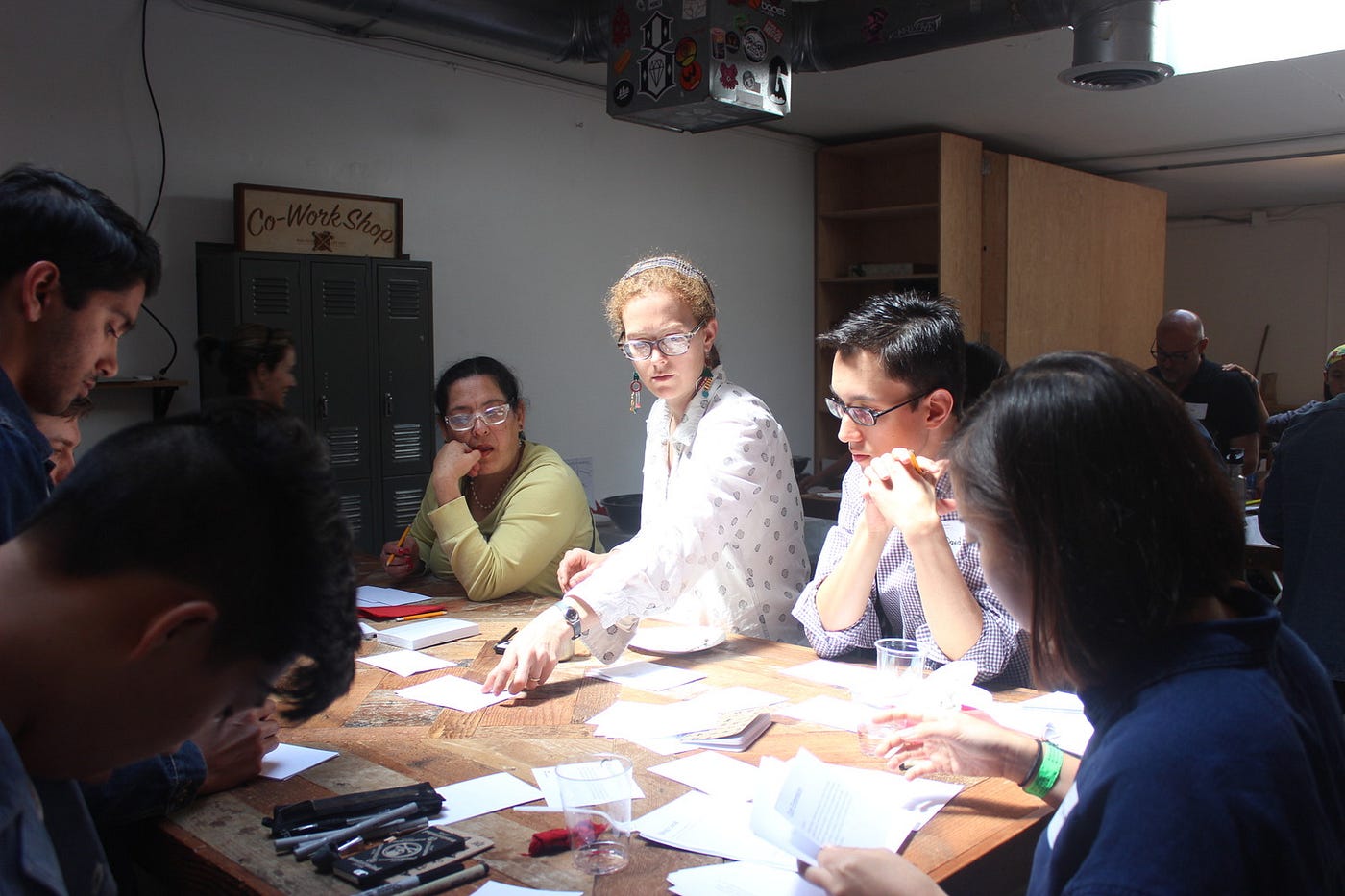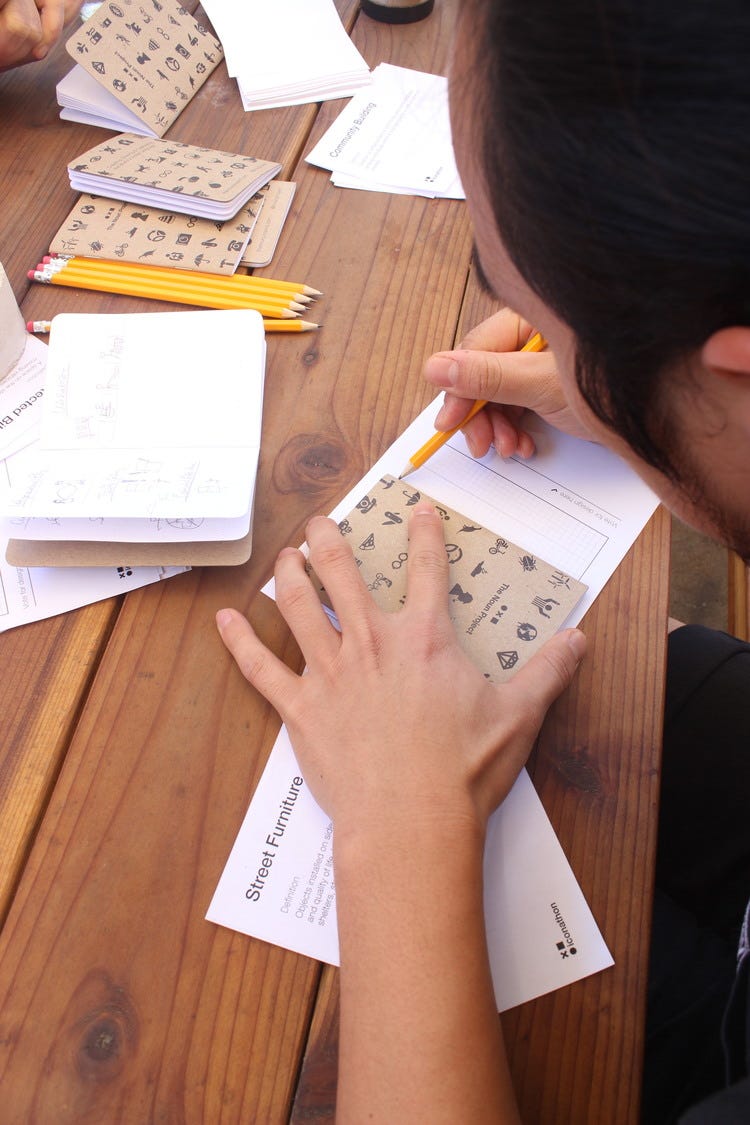Have you ever strolled past a parklet, or a sidewalk extension with what seems to be seating and tables, but weren’t sure if you could sit there? Are you able to imagine what this parklet looks like, let alone the intention behind it?

Upon first glance at its linguistic form, we found ourselves scanning the dusty compartments of past memories to bring back meaning to a “parklet,” a technical term commonly used in urban design and planning amongst numerous referents. A parklet is a people-oriented mini park in place of a vehicle parking spot, and it wasn’t until we saw a visual depiction of it when we experienced an aha moment.
With literacy statuses, cultural barriers and our very own experience in mind, Noun Project hosted a Great Streets Iconathon in partnership with the Office of LA Mayor Eric Garcetti and Goldhirsh Foundation to help create the visual language that invites LA citizens to engage in public spaces.


In 2014, Mayor Garcetti announced 15 main streets in 15 different neighborhoods as part of the Great Streets initiative. With the helping hands of neighborhood hub Mar Vista Art Dept, the Iconathon took place at a co-shop-work space situated on Venice Boulevard, right on a designated Great Streets corridor.

A diverse scope of people lent their creativity and unique perspectives at the public design workshop including volunteers, graphic designers, community organizers, policy makers, students, families & youth.




Naomi Iwasaki, Great Streets Program Director, kicked off our discussion on Great Street concepts. Edward Boatman, co-founder of Noun Project, presented on semiotics and best practices for designing icons. Angie Jean-Marie, social innovator from Goldhirsh Foundation, helped connect the dots in support of re-imagining the future of Los Angeles.
We saw people from all walks of life gather in the heart of Mar Vista to reimagine our LA neighborhoods as vibrant, empowering, and safe spaces. Citizens, designers & subject matter experts alike brainstormed visual depictions of the following 24 referents with a focus on 6 main categories.
Economic Activity
- Shop local / support small business — Campaign to encourage consumers to buy products from businesses within the local community.
- Economic revitalization — Renewing commercial and/or retail activity in response to historic disinvestment or other economic hardship.
- Street vending — Sale of goods or services from mobile stalls on sidewalks and in parks without a permanent storefront.
Access & Mobility
- Protected bike lane — Dedicated space on the street for people riding bikes, buffered from moving vehicles by a physical barrier.
- Continental crosswalk — Pedestrian crosswalks designed for the highest level of visibility and safety for all street users; consists of a series of wide painted stripes parallel to the curb.
- Multi-modal — Represents the choices of travel that should be safe, comfortable, affordable, accessible, and convenient for a diverse range of users, including but not limited to, public transportation, bicycling, and walking.
- Curb extension — A street design treatment designed to reduce high vehicle speeds (calms traffic) by extending the sidewalk and shortening the distance for a pedestrian to cross. Also helps drivers better see pedestrians while turning and also physically requires a vehicle to slow down for right-hand turns due to a tighter curb radius. Also called “bump-outs” or “bulb-outs”.
- Walkability — A measure of how welcoming an area is to people walking. Factors influencing walkability include the prevalence and quality of sidewalks, traffic and road conditions, land use patterns, and safety. Experiences of people in wheelchairs, pushing strollers and carts, and other travel modes allowed on sidewalks are also considered in measuring “walkability”.
Neighborhood Identity & Civic Pride
- Placemaking — A collaborative approach to the planning, design, and management of public spaces that capitalizes on a local community’s assets and inspiration. Focuses on creating a safe, accessible, and contextually appropriate public space that meet needs and promote health, happiness, and well-being in a local neighborhood. Related to “placekeeping”, which refers to sustaining safe, accessible public places.
- Parklet — An expansion of the sidewalk by transforming one or more on-street vehicle parking space(s) into people-oriented mini parks. May feature seating, tables, and other amenities.
- Vacant lot activation — A strategy to revitalize neighborhoods by programming underutilized plots of land thereby fostering a stronger community identity and sense of place.
- Community garden — A plot of land gardened collectively by community stakeholders, which helps foster social cohesion, brings nature to urban areas, and provides a potential source of freshly grown local food.
Health Outcomes
- Play Street — A temporarily car-free street that provides children and communities with open space to engage in active play and physical activity. Typically applied in neighborhoods with little access to safe parks and open space.
- Intergenerational play — Opportunities for play relevant to people of all ages, which provides greater creativity and higher levels of language and problem-solving skills for children, and psychological and health benefits, including reducing stress and promoting relaxation for adults.
Community Engagement & Social Connection
- Street furniture — Amenities installed on sidewalks and streets to improve safety and quality of life. Includes benches, transit stops and shelters, street lighting, and trash receptacles. Also called “sidewalk furniture”.
- Vibrant public spaces — Accessible, comfortable, sociable spaces where a diverse range of people are engaged in a variety of activities.
- Cultural activities / community gatherings — Events that provide opportunities to bring people together on streets and in public spaces, while helping build community capacity.
- Community-led design — Planning process that positions local community members at the center of making changes in their neighborhoods.
- Community building — Creation or enhancement of community and connectedness among individuals within a local geography or with a common interest.
Environmental Resilience
- Drought-tolerant landscape — Using plants that are appropriate for the local climate can greatly reduce urban water consumption.
- Stormwater recapture — Capturing rainfall and runoff from open space and urban lands for either direct use or allowing the water to percolate into groundwater basins for future use.
- Green Alleyways — Transformation of underutilized or unsafe alleys into safe, clean, green, community spaces.
- Tree canopy — The shade and cover provided by tree branches, leaves and flowers, which can reduce temperatures in hot urban areas, improve the walking experience and bring landscaping to concrete sidewalks.


Graphic tools to be used for inspiring positive action in the public way and creating literal “front porches” for our great LA neighborhoods.
The visual language, made by the people, will return home to Venice Boulevard as well as live on our other LA Great Streets in the manifestation of metal signs printed by the LA Department of Transportation for people to engage with.

Big thanks to our passionate LA Great Streets Iconathon attendees as well as community partners, Mar Vista Art Dept, Atmosphere Cafe and 826LA. We couldn’t have done this without you!
The icons are now in the public domain and available for free download on Noun Project.
The icons created from this Iconathon will be used by the Office of LA Mayor Eric Garcetti and Goldhirsh Foundation to communicate the works of urban design concepts, along with any other cities in need of graphic tools to denote actionable concepts to build and sustain livable communities.
View and download the full collection here.
Photo credit: Jeffrey Tang / 12FV




